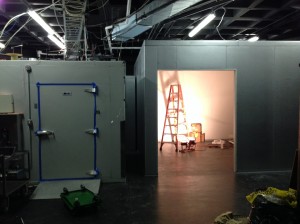Work continues on various aspects of the new tracker. In the electrical room one of our E. techs installed a new
Phase Control Modification circuit for the LER Servo Driver cabinets and successfully tested its operation. This will be critical if we were to loose just one phase of power. One of the other E. techs and a programmer from one of our partners in Germany have started working on the VIRUS enclosure PLC for monitoring the sensors within the enclosure. They tested each sensor and mute switch; all worked as expected. End to end testing will be done next week. Meanwhile the mechanical team worked on the Platforms for the first Virus Enclosure. It took several days but all of the platforms are now in.
After the interruptions due to weather and the problems of the loose screws from last week we are finally back on sky this week. Night operations commissioning started with the first data sets for structure and tracker sag models. This is done with the small celestron telescope mounted on the tracker. After the engineering tasks were complete,
the telescope operator was able to find all of the mirrors (with some assistance of the mirror team who sited some of them in from the catwalk). Mirror alignment for the full array is now near 0.5″.
Work continues on the commissioning of the strip and wash room. We finished working on the PID control of the strip/wash room exhaust fan. Fan will now respond to pressure setting change requests from within the strip/wash room and regulate the pressure to previously established set points. This will allow the team to switch from positive pressure while washing or drying mirrors to negative pressure when doing acid stripping.
We reviewed spectrograph room temperature data and discovered that we have dropped below the cooling temperature settings of the Mitsubishi thermostats/control heads, this is largely due to the thermal pulse moving through the ground produced by our <20 F temperatures last week. We have designed a new experiment to determine the optimum method to hold the 16 C setpoint during periods where both heating and cooling are required. We hope this new methodology will work. If not then we will need a PID controller which will require significant more work.

